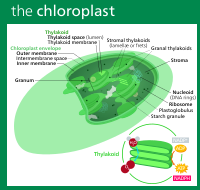
Photo from wikipedia
In plants, plastids are thought to interconvert to various forms that are specialized for photosynthesis, starch and oil storage, and diverse pigment accumulation. Post-endosymbiotic evolution has led to adaptations and… Click to show full abstract
In plants, plastids are thought to interconvert to various forms that are specialized for photosynthesis, starch and oil storage, and diverse pigment accumulation. Post-endosymbiotic evolution has led to adaptations and specializations within plastid populations that align organellar functions with different cellular properties in primary and secondary metabolism, plant growth, organ development and environmental sensing. Here, we review plastid biology literature in light of recent reports supporting a class of 'sensory plastids' that are specialized for stress sensing and signaling. Abundant literature indicates that epidermal and vascular parenchyma plastids display shared features of dynamic morphology, proteome composition and plastid-nuclear interaction that facilitate environmental sensing and signaling. These findings have the potential to reshape our understanding of plastid functional diversification.
Journal Title: Journal of experimental botany
Year Published: 2022
Link to full text (if available)
Share on Social Media: Sign Up to like & get
recommendations!